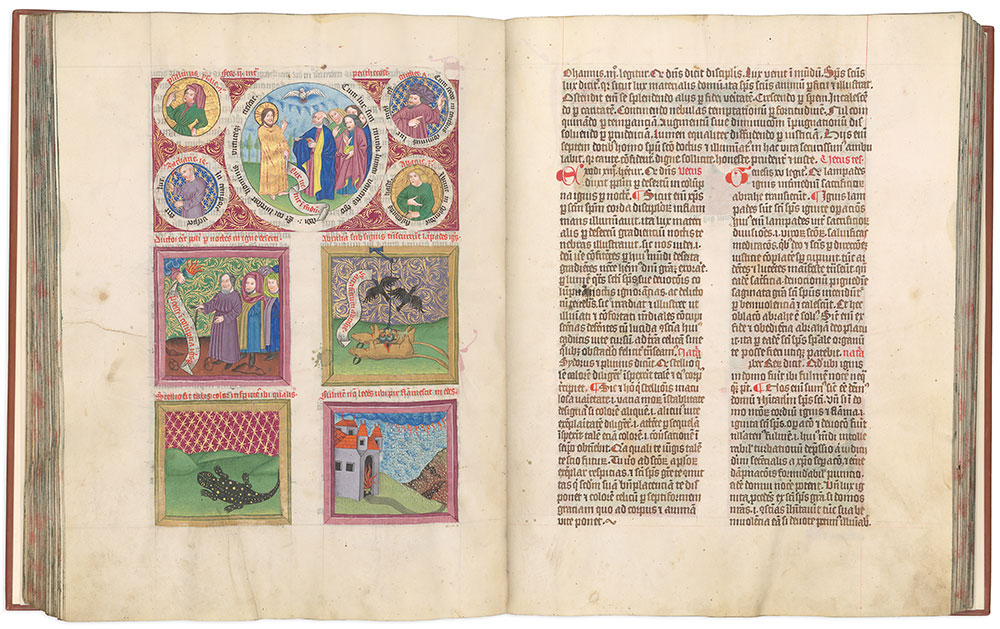
HISTORIES OF SALVATION
This compendium systematically links prefigurations from the Old Testament and the natural world to their Christian realizations in the New Testament. At top, for example, the principal scene is Christ telling Nicodemus that light has come into the world. Directly below are two scriptural prefigurations: Moses and the Israelites led by a pillar of fire, and God’s covenant with Abraham. There follow two examples from natural history: a chameleon, and a burning house in a hailstorm. Just as the lizard takes on the color of its surroundings, so an observer can adopt exemplary behavior. Just as hail and lightning cannot harm a blazing house, so the Last Judgment cannot harm one ablaze with the Holy Spirit. This opulent copy was made for Leonhard Dietersdorfer, a cleric and imperial notary from Salzburg.
Ulrich of Lilienfeld
(ca. 1308–1358)
Concordantia caritatis (Concordance of Charity), in Latin and German
Austria, Vienna, ca. 1460
The Morgan Library & Museum, MS M.1045, fols. 120v–121r
Gift of Clara S. Peck, 1983
Jeffrey Hamburger, Kuno Francke Professor of German Art & Literature, Harvard University
The Concordance of Charity, written between 1345 and 1351 by Ulrich, abbot of the Cistercian monastery of Lilienfeld in Austria, represents the most ambitious handbook of its kind from the Middle Ages. Typological in character, the work follows the liturgical calendar. Employing types drawn from nature as well as Scripture, it incorporates a moralized bestiary into an exposition of salvation. With 248 groups of images totaling over 1,000 illustrations, it is no wonder that this opulently decorated copy commissioned by Leonhard Dietersdorfer—a cleric and notary of Salzburg as well as a master of theology—was never completed.
At the top of the page exhibited here, four prophets surround the principal subject: Christ telling Nicodemus that light has come into the world a scene selected for the Monday after Pentecost.
The lower part of the page presents four types: Moses and the Israelites led by a pillar of fire and God’s covenant with Abraham. Having been asked to sacrifice a heifer, a goat, a ram, a dove, and a pigeon, Abraham cuts them all but the fowl in half. Birds of prey descend and are driven away. Then, after sunset, “there arose a dark mist, and there appeared a smoking furnace and a lamp of fire.” The artist condenses all this into a single miniature in which the furnace and lamp hang from a hook projecting from the upper frame. Connecting both images to Pentecost is the common theme of fire descending from the heavens.
Lower still are two types drawn from natural history: on the left a chameleon; on the right, a burning house in a hailstorm. Just as the lizard takes on the color of its surroundings, so too an observer adopts the exemplary behavior of someone he sees. And just as hail and lightening do not endanger a house that is already ablaze, so the Last Judgment cannot endanger someone whose heart is already ablaze with the fire of the Holy Spirit.
